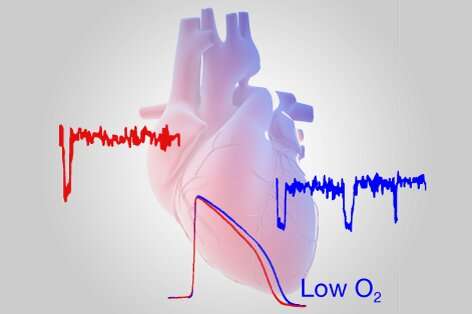Study reveals how low oxygen levels in the heart predispose people to cardiac arrhythmias

Low oxygen levels in the heart have long been known to produce life-threatening arrhythmias, even sudden death. Until now, it was not clear how.
New findings, in a study led by Steve A. N. Goldstein, MD, Ph.D., vice chancellor for Health Affairs at the University of California, Irvine, and distinguished professor in the UCI School of Medicine Departments of Pediatrics and Physiology & Biophysics, reveal the underlying mechanism for this dangerous heart disorder.
"Our research shows that within seconds, at low levels of oxygen (hypoxia), a protein called small ubiquitin-like modifier (SUMO) is linked to the inside of the sodium channels which are responsible for starting each heartbeat," said Goldstein. "And, while SUMOylated channels open as they should to start the heartbeat, they re-open when they should be closed. The result is abnormal sodium currents that predispose to dangerous cardiac rhythms."
Titled, "Hypoxia produces pro-arrhythmic late sodium current in cardiac myocytes by SUMOylation of NaV1.5 channels," the study was published today in Cell Reports. Lead author, Leigh D. Plant, Ph.D., assistant professor at the Bouvé College of Health Sciences, Department of Pharmaceutical Sciences at Northeastern University, was a former post-doctoral fellow with Dr. Goldstein.
Every heartbeat begins when sodium channels open and ions to rush into heart cells—this starts the action potential that causes the heart muscle to contract. When functioning normally, the sodium channels close quickly after opening and stay closed. Thereafter, potassium channels open, ions leave the heart cells, and the action potential ends in a timely fashion, so the muscle can relax in preparation for the next beat. If sodium channels re-open and produce late sodium currents, as observed in this study with low oxygen levels, the action potential is prolonged and new electrical activity can begin before the heart has recovered risking dangerous, disorganized rhythms.
Fifteen years ago, the Goldstein group reported SUMO regulation of ion channels at the surface of cells, an unexpected finding since the SUMO pathway had been thought to operate solely to control gene expression in the nucleus.
"This new research shows how rapid SUMOylation of cell surface cardiac sodium channels causes late sodium current in response to hypoxia, a challenge that confronts many people with heart disease," said Goldstein. "Previously, the danger of late sodium current was recognized in patients with rare, inherited mutations of sodium channels that cause cardiac Long QT syndrome, and to result from a common polymorphism in the channel we identified in a subset of babies with sudden infant death syndrome (SIDS)."
The information, gained through the current study, offers new targets for therapeutics to prevent late current and arrhythmia associated with heart attacks, chronic heart failure and other life-threatening low oxygen cardiac conditions.
More information: Leigh D. Plant et al, Hypoxia Produces Pro-arrhythmic Late Sodium Current in Cardiac Myocytes by SUMOylation of NaV1.5 Channels, Cell Reports (2020). DOI: 10.1016/j.celrep.2020.01.025

















